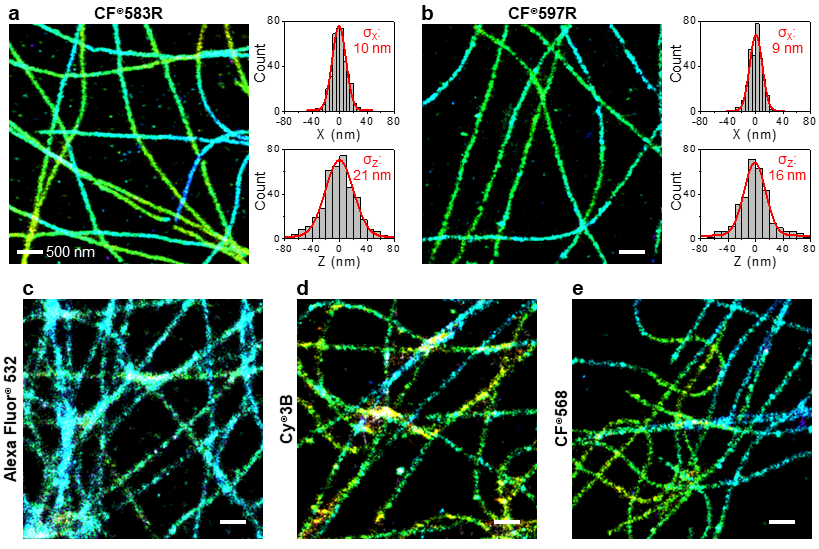Content #1
Content #1
Content #1
Super-resolution microscopy is an exciting new field for fluorescence microscopy that overcomes the barriers for image resolution imposed by the diffraction limit of light. Stochastic optical reconstruction microscopy (STORM) is a type of super-resolution imaging that uses stochastic on-off switching of single-molecule fluorescence to localize millions of molecules over many camera frames to produce images with ~10 nm spatial resolutions. Direct stochastic optical reconstruction microscopy (dSTORM) methods, based on photoswitching of synthetic dyes, have high single-molecule brightness and resolution. However, high-quality multicolor dSTORM remains difficult due to the lack of ideal dyes outside of the red excitation range (e.g., 633 or 640 nm).
In a recent publication in Angewandte Chemie, B. Wang et al. from UC Berkeley, in collaboration with Biotium scientists, proposed a strategy to improve the photoswitching behavior of rhodamine dyes, leading to the development of two green-excitable dyes for high quality multi-color STORM imaging. The photoswitching mechanism of rhodamine dyes can be induced under reducing conditions to generate a long-lived photoactivated radical dark state, which reverts to a fluorescence emitting state with violet light or the addition of oxygen. Using this knowledge, the authors successfully developed two rhodamine-based dyes, CF®583R and CF®597R, by replacing the benzene ring in the rhodamine core with a positively charged 1,3-disubstituted imidazolium, which would further stabilize the radical through a resonance structure. Experiments done with these dyes showed fast on-off switching, long lasting blinking, and bright single-molecule emission, characteristics of high performance dSTORM dyes. The novel, green-excited dyes demonstrated similar results to validated, red-excited dyes in the same imaging buffer.
The authors compared the spectral behavior of CF®583R and CF®597R with other green-excited dSTORM dyes, such as Alexa Fluor® 532, Cy®3B, Atto 565, and Alexa Fluor® 568. These older generation dyes showed very limited photoswitching, while CF®583R and CF®597R showed substantially higher rates of photoswitching. CF®583R and CF®597R both yielded high-resolution images, with better uniformity and continuity than the other green-excited dyes tested. Based on these results, the authors concluded that replacing the benzene ring with a positively charged imidazolium sensitized rhodamine-based dyes towards photoswitching in the dSTORM buffer with improved imaging results. The images produced using this protocol were high quality and on par with those obtained using red-excited dyes. This chemical strategy can therefore be used to develop other fluorescent dyes for STORM imaging, advancing potential for multi-color super-resolution microscopy.

Learn more about Biotium’s CF® Dyes, and their unrivaled performance for super-resolution applications.
Full Citation:
Wang, B., Xiong, M., Susanto, J., Li, X., Leung, W. Y., & Xu, K. (2021). Transforming Rhodamine Dyes for (d)STORM Super‐Resolution Microscopy via 1,3‐Disubstituted Imidazolium Substitution. Angewandte Chemie. https://doi.org/10.1002/ange.202113612